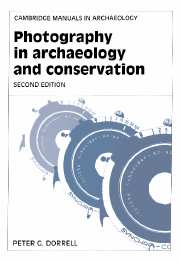Book contents
- Frontmatter
- Contents
- List of illustrations
- Preface
- Preface to the second edition
- Acknowledgements
- 1 The early days of archaeological photography
- 2 Basic principles and practice
- 3 Equipment
- 4 Lighting by flash
- 5 Photographic materials, processing and printing
- 6 Architecture and standing monuments
- 7 Survey photography
- 8 Site photography
- 9 Principles of object photography
- 10 Principles of close-up photography
- 11 Ultra-violet and infra-red photography
- 12 Photographing finds
- 13 Flat copy
- 14 Preparation of material for publication
- 15 The future
- References
- Index
10 - Principles of close-up photography
Published online by Cambridge University Press: 23 December 2009
- Frontmatter
- Contents
- List of illustrations
- Preface
- Preface to the second edition
- Acknowledgements
- 1 The early days of archaeological photography
- 2 Basic principles and practice
- 3 Equipment
- 4 Lighting by flash
- 5 Photographic materials, processing and printing
- 6 Architecture and standing monuments
- 7 Survey photography
- 8 Site photography
- 9 Principles of object photography
- 10 Principles of close-up photography
- 11 Ultra-violet and infra-red photography
- 12 Photographing finds
- 13 Flat copy
- 14 Preparation of material for publication
- 15 The future
- References
- Index
Summary
In the course of recording finds from an excavation, and more especially during the conservation and study of artifacts, it is often necessary to take series of photographs of small objects, or of small parts of objects, at magnifications of around 1:1, i.e. life size on the final print, or larger. The kinds of object for which such close-up photography may be required are coins and beads, brooches and fibulae, scarabs, seals and seal impressions, tablets, flints, sherds, and fragments of fabric, bone, metal and glass, as well as non-artifacts like fossils, grain, teeth and plant fibres (see Chapter 12).
The techniques of such photography are, in essentials, no different from those of straightforward object photography discussed earlier. There are a few special requirements of arrangement, equipment, lighting and exposure, however. The study of artifacts also sometimes calls for photography at much higher magnifications, between about 5:1 and 20:1, and although standard equipment can be used for this, the requirements of lighting are rather different, and new factors enter into the selection of optimal lens apertures.
Cameras
There is no doubt that the best results in close-up photography are obtained with a large-format camera – 5 × 4 in or even larger – especially if a considerable magnification is needed. In principle, as much magnification as possible should be achieved on the negative, rather than in the enlarger. The fineness of detail that can be recorded is a function of both optical resolution – the extent to which the lens can separate adjacent points – and chemical resolution – the size of the finest detail compared with the size of silver grains in the emulsion.
- Type
- Chapter
- Information
- Photography in Archaeology and Conservation , pp. 177 - 197Publisher: Cambridge University PressPrint publication year: 1994



